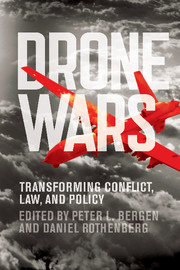Book contents
- Frontmatter
- Contents
- Contributors
- Acknowledgments
- Introduction
- Part I Drones on the Ground
- Part II Drones and the Laws of War
- 6 It Is War at a Very Intimate Level
- 7 This Is Not War by Machine
- 8 Regulating Drones
- 9 A Move Within the Shadows
- 10 Defending the Drones
- Part III Drones and Policy
- Part IV Drones and the Future of War
- Index
- References
8 - Regulating Drones
Are Targeted Killings by Drones Outside Traditional Battlefields Legal?
Published online by Cambridge University Press: 05 December 2014
- Frontmatter
- Contents
- Contributors
- Acknowledgments
- Introduction
- Part I Drones on the Ground
- Part II Drones and the Laws of War
- 6 It Is War at a Very Intimate Level
- 7 This Is Not War by Machine
- 8 Regulating Drones
- 9 A Move Within the Shadows
- 10 Defending the Drones
- Part III Drones and Policy
- Part IV Drones and the Future of War
- Index
- References
Summary
Law and Targeted Killings
Targeted killing is nasty business, however carried out. For the US government, the pace of targeted drone strikes has quickened dramatically in the early years of the Obama administration. If the use of sophisticated armed drone technology has become the contemporary weapon of choice for responding to terrorists and insurgents who wantonly cause civilian deaths, US policymakers, as well as society at large, have an obligation to see to it that the weapons and their use are subject to a tightly managed and accountable set of legal controls that are as transparent as possible.
After the George W. Bush administration deployed drones in the Afghanistan and Iraq wars and introduced cross-border strikes in Pakistan as an adjunct to the Afghan campaign, the Obama administration accelerated their use. Central to this process was the role of targeted killing as a key element of counterterrorism and counterinsurgency campaigns against al-Qaeda, the Taliban, and associated groups. As early as 2009, commenting on the use of drones for targeting killings in Pakistan, the former director of the CIA, Leon Panetta, said, “It’s the only game in town in terms of confronting or trying to disrupt the al Qaeda leadership.” Meanwhile, public support for the policy was strong. A January 2012 ABC News–Washington Post poll found that 83 percent of Americans approved of the administration’s use of drones for targeted killing of terrorist suspects.
- Type
- Chapter
- Information
- Drone WarsTransforming Conflict, Law, and Policy, pp. 129 - 159Publisher: Cambridge University PressPrint publication year: 2014
References
- 1
- Cited by



